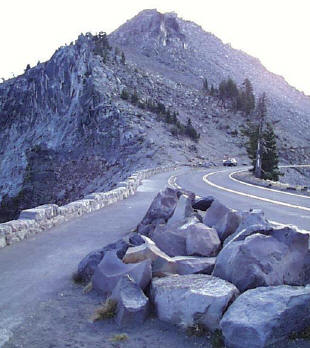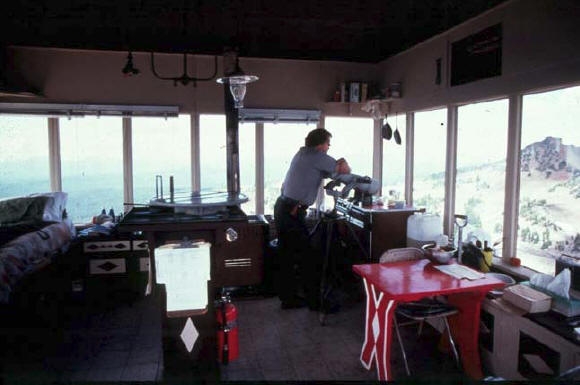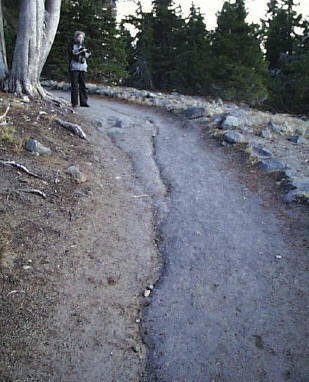National Park Service Cultural Landscapes Inventory: The Watchman, Crater Lake National Park, 2001
Physical History
1972-Present
By the early 1970s, construction and development programs were reduced in the park, but interpretation at Watchman Observation Station remained a priority and was included in the 1972 interpretive plan the park. The concept was to thematically relate wayside exhibits around Rim Drive, including the wayside located on the Watchman parapet, on the north side of the observation station. The plan noted that “personal contact by an onsite interpreter, supplemented by several exhibits mounted at low levels around the parapet” were to be utilized at the site (Unrau, 1988, 665). In addition, the plan proposed no change in trailside interpretation, as The Watchman Trail was “heavily used” (Unrau, 1988, 666). Watchman Observation Station and Watchman Trail were therefore used much in the same manner as before and after WWII. This historic use was to change by 1975 with the exhibits dismantled in the museum.
Also by 1975, Watchman Observation Station was no longer regularly staffed during the summer months for fire protection purposes (Greene, 1984, 249-50) and interpretation involved less personal contact with park visitors by interpretive staff, in favor of interpretive signage. The 1985 interpretive plan mentioned the self guided interpretive waysides along the trail, but no attempt was made to thematically relate the content of the signs. Unlike the 1972 interpretive plan, the 1985 plan did not mention personal contact with park visitors at the observation station (Guiney, 1984, n.p.).
During this period in 1986, the observation station fell into disrepair. In a memorandum from Jonathan Jarvis to the Superintendent, the structure was reported to be in poor condition, “seriously suffering from years of neglect and heavy snows”. Climatic forces had taken their toll on the building, with high winds having knocked out windows and the roof sagging from rotten joists. Moreover, Jarvis explained that the building was “historically significant”, important to the park’s air-quality and fire management programs, and “of all the historic structures in the park…the most seriously jeopardized by neglect, and in need of emergency repairs” (Jarvis, 1986, n.p.). Throughout the 1980s to the present day, Watchman Observation Station has incurred damage to its structure and required repair.
Plans to rehabilitate Watchman Observation Station began with $50,000 earmarked in fiscal year 1993 to repair leaks and other damages to the building (Mark, 1993, n.p.). This project, however, was not successful in rehabilitating the structure. By 2000, $435,000 of Fee Demo monies was slated to bring Watchman Observation Station back to the “same “look” of the year it opened in 1932–“with the amenities needed in a new millennium” (Juillerat, 2000, n.p.). Due to budget shortfalls, however, the rehabilitation was not completed.
At present, Watchman Observation Station is staffed during the summer months while the museum remains closed to the public. Visible damage, some of it due to vandalism, is evident and more repairs are necessary to rehabilitate the structure. The Watchman Trail remains open to the public, but is in fair condition as a result of the repair work conducted in 2000. Currently, funding has been earmarked for repairs to Watchman Trail.
 |
| Contemporary photograph of Watchman Peak (8013′) taken from Watchman Overlook. Watchman Observation Station is located at the summit. Watchman Trail begins at this point (CCSO 2001). |
 |
| Historic photograph from 1985 showing a National Park Ranger working at the Watchman Observation Station, no date (CRLA slide files). |
 |
| Contemporary photograph showing Watchman Trail and erosion caused by harsh climatic conditions at Crater Lake National Park (CCSO 2001). |
Other pages in this section

